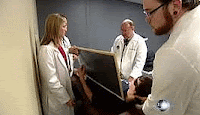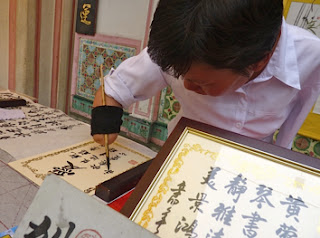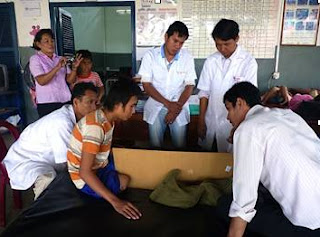Excerpt: On 11/26/12, James Dao of The New York Times reported on Cpl. Sebastian Gallegos of the Marines who is among a small group of upper limb amputees who have had a pioneering surgery, known as targeted muscle reinnervation, that amplifies nerve signals that control prosthetic arms. He wears a $110,000 robotic device with an electronic motor and sensors able to read signals from his brain.
Of the more than 1,570 American service members who have had arms, legs, feet or hands amputated because of injuries in Afghanistan or Iraq, fewer than 280 have lost upper limbs. Their struggles to use prosthetic limbs are in many ways far greater than for those who have lost lower-limbs.
With myriad bones, joints and ranges of motion, the upper limbs are among the body’s most complex tools. Replicating their actions with robotic arms can be excruciatingly difficult, requiring amputees to understand the distinct muscle contractions involved in movements they once did without thinking.
Upper limb amputees must also cope with the critical loss of sensation. Touch, the ability to differentiate baby skin from sandpaper or to calibrate between gripping a hammer and clasping a hand, no longer exists.
For all those reasons, nearly half of upper limb amputees choose not to use prostheses, functioning instead with one good arm. By contrast, almost all lower limb amputees use prosthetic legs.
Further information is in the complete NY Times article.
Updates and reflections on Mirror Therapy and related non-invasive techniques to reduce or eliminate Phantom Limb Pain globally for amputees and the work of non -profit End The Pain Project to accomplish these goals.
Sunday, December 2, 2012
Friday, November 2, 2012
'Brain Scrambler' Aids Phantom Limb Pain
Walter Reed Army Medical Center is now using Calmare Therapy as one of its methods used to eliminate phantom pain for amputees.
This therapy uses a biophysical rather than a biochemical approach. A 'no-pain' message is transmitted to the nerve via disposable surface electrodes applied to the skin in the region of the patient's pain. The perception of pain is cancelled when the no-pain message replaces that of pain, by using the same pathway through the surface electrodes in a non-invasive way.
Calmare Therapy Video
This therapy uses a biophysical rather than a biochemical approach. A 'no-pain' message is transmitted to the nerve via disposable surface electrodes applied to the skin in the region of the patient's pain. The perception of pain is cancelled when the no-pain message replaces that of pain, by using the same pathway through the surface electrodes in a non-invasive way.
Calmare Therapy Video
Friday, October 26, 2012
Ho Offers Calligraphy Catalog
A 24-page catalog of Ho, the amputee calligrapher's original work is now available from Malaysia. The self-taught calligrapher managed to develop her own style of calligraphy after losing her upper limbs after an accident in 1990.
The cost is $6.00 or RM18 plus $3.00 or RM9 postage. Contact:
He Lan Gui, 12F Jalan Hanag Jabet, 75200 Malacca Malaysia
Sunday, August 26, 2012
ABC News Interview With Dr. Ted Carrick
A fascinating ABC Chiropractic Neurology Interview with Dr Ted Carrick, a chiropractic neurologist of Marietta Georgia on the many non-invasive modalities he combines to correct the effects of brain trauma. In the clip, a young athlete with severe brain injury achieves dramatic movement success with the use of mirror therapy.
Monday, August 13, 2012
The Courage of Dr. BJ Miller
We at End The Pain Project are deeply impressed by the compassion and courage of Dr. Miller, a triple amputee and current head of the SF Zen Hospice Project. Read the full article at SF Gate.
Labels:
amputees,
BJ Miller,
Dr,
End The Pain Project,
Zen Hospice Project
Tuesday, June 5, 2012
IASP Insight article by Moira Judith Mann: Vietnam Mirror Therapy Project Expands to Cambodia
The International Association for the Study of Pain's first issue of its printed member newsletter, IASP Insight, includes Moira Judith Mann's Vietnam Mirror Therapy Project Expands to Cambodia. The full article, which appears on pages 16-17 in the June 2012 newsletter, can be read online at: http://www.iasp-pain.org/Content/NavigationMenu/Publications/IASPInsight/default.htm
Friday, June 1, 2012
Your Vote Needed by June 7 For ETPP to Win $5000
 End The Pain Project Needs Your Vote by June 7 to Win $5000 for
2012 Amputee Projects in Rwanda & Indonesia
End The Pain Project Needs Your Vote by June 7 to Win $5000 for
2012 Amputee Projects in Rwanda & IndonesiaMoira Judith Mann, Co-Founder of End The Pain Project,has been selected as a finalist in the first online Marigold Ideas For Good Contest - http://www.takepart.com/
And that's where you come in -- to cast your vote each day through June 7, and also urge your friends to vote daily for Moira Judith Mann before the contest ends at http://www.takepart.com/
What will End The Pain Project achieve when Moira Judith wins?
When you vote for Moira Judith Mann, you are voting to help End The Pain Project win $5,000. This prize will be dedicated In 2012-13 to:
- Bring Mirror Therapy training workshops to facilitators and
amputees in Indonesia. Loss of limbs in Indonesia are due to the
2005 tsunami, road accidents, leprosy and other diseases.
- Send unbreakable mirrors to amputees in Rwanda along with
Mirror Therapy training materials. Jean De Dieu Tuyisenge, a
Rwandan-Canadian who lost a leg as the result of a machete
attack, is currently helping End The Pain Project to network
with rehabilitation and health centers that assist some of the
26,000 Rwandan amputees. Most are survivors of the 1994
genocide.
for further information about ETPP, please click http://endthepainproject.org and http://endthepainprojectupdate.blogspot.com.
Thank you for your support!
Sunday, January 29, 2012
Sin Chew Daily, the Malaysian Chinese-language newspaper, publishes article by Ng Yen Choo about Hoe the amputee calligrapher and ETPP on the front page of its Melaka, Malaysia edition in January, 2012.
Labels:
ETPP,
Hoe,
Melaka Malaysia,
Ng Yen Choo,
Sin Chew Daily
Sunday, January 22, 2012
HOE --AN INSPIRED AMPUTEE CALLIGRAPHER
Meet Hoe, whom I met on my recent trip to SE Asia to teach mirror therapy ... one of the most amazing people on the face of the earth. --Moira Judith Mann
Hoe, a 42-year old double upper limb amputee is a self-taught calligrapher who started practicing the art twenty years ago after an industrial accident in China severed her left arm and her right hand.
Hoe straps a calligraphy brush to her right arm stub and then, as she reports, uses her phantom hand to guide her strokes.
Hoe produces calligraphy by donation from a street stand in Malaka, Malaysia, supporting two daughters going to university in China with her earnings.
Even twenty years after her accident, Hoe experiences phantom limb pain, particularly in the remaining stub of her left arm. End The Pain Project has taken steps to relieve this pain through various methods, including Farabloc and an EMF band.
Hoe has great dignity and focuses on perfecting her calligraphy style. She hopes to inspire other amputees through her efforts.
Hoe explaining her calligraphy at her street stand in Melaka, Malaysia.
Hoe and Moira Judith Mann, Co-Founder of End The Pain Project in December 2011, Melaka Malaysia.
Hoe, a 42-year old double upper limb amputee is a self-taught calligrapher who started practicing the art twenty years ago after an industrial accident in China severed her left arm and her right hand.
Hoe straps a calligraphy brush to her right arm stub and then, as she reports, uses her phantom hand to guide her strokes.
Hoe produces calligraphy by donation from a street stand in Malaka, Malaysia, supporting two daughters going to university in China with her earnings.
Even twenty years after her accident, Hoe experiences phantom limb pain, particularly in the remaining stub of her left arm. End The Pain Project has taken steps to relieve this pain through various methods, including Farabloc and an EMF band.
Hoe has great dignity and focuses on perfecting her calligraphy style. She hopes to inspire other amputees through her efforts.
Hoe explaining her calligraphy at her street stand in Melaka, Malaysia.
In February, 2012, Shannon Nill, an upper arm amputee from Oregon, displays the calligraphy created for him by Hoe in gratitude for an EMF band donated by Nill that helps her sleep. Nill uses the EMF band for sounder sleep as well.
Labels:
calligraphy,
End The Pain Project,
ETPP,
Farabloc,
Moira Judith Mann
Mirror Therapy Training at Three (VIC) Veterans International Cambodia Physical Rehabilitation Centers - 12/2011 -01/2012
This is an account of a recent mirror therapy training trip taken by Moira Judith Mann, Co-Founder of End the Pain Project to Cambodia. The results indicate that mirror therapy to alleviate phantom limb pain for the many amputees in Cambodia will be spread by the 29 physiotherapists who participated in the workshops. ETPP Workshops in other third world countries with large amputee populations can be made possible with your support.
Khuonh Barang, 24, lost his leg above the knee six months ago in a road accident. He suffers phantom limb pain which he feels in the toes and sole of his phantom leg and most of the time he feels heat at the same places.
Physiotherapists at the Veterans International Cambodia Physical Rehabilitation Center in Kratie, Cambodia, prepare Khuong Barang for a Mirror Therapy session. They explain the purpose and instruct to Barang.
Song Sit, PT Clinical Mentor instructs a Technical Coordinator at Kratie Physical Rehabilitation Center with initial assisted Mirror Therapy movements.
Song Sit explains the suggested schedule for Barang for self-administered Mirror Therapy. Barang was given an instruction print-out with his native language to follow each day.
Khuonh Barang reports that after 20 minutes of concentrating on the mirror image of his intact leg, he no longer feels hot in the sole of his phantom foot and that the pain was highly reduced.
The day after the initial Mirror Therapy, Khuonh Barang reported better sleep and seemed in higher spirits than the day before.
A positive response to Mirror Therapy was reported by the diabetic amputee to the clinical staff at Kratie Center.
Ms. Um Naikim, a Prosthetist and Orthotist, uses ETPP Table Top Mirror Tent for practice at Kien Khleang National Rehabilitation Center for the Disabled,.
Mr. Wa Sarun, a bench technician at the Kien Khleang Physical Rehabilitation Center for the Disabled and an amputee, was sceptical about the benefits of Mirror Therapy prior to working with a mirror.
After one session, his experience convinced Mr. Wa that Mirror Therapy was effective in subduing an almost constant pain he has endured since stepping on a land mine.
Mr. Ull Meng Hour, Site Manager of the Prey Veng Physical Rehabiitation Center stepped on a land mine in 1984 and still suffers periodic bouts of phantom limb pain.
Mr. Ull had positive results from his first session of Mirror Therapy. He concentrates on the mirror image of his intact leg using a distortion-free unbreakable plastic donated by the non-profit charity, End The Pain Project.
Prey Veng Physical Rehabilitation Center. clinical staff concentrating on mirror images.
Physiotherapist, Prosthetist and Orthotist at Prey Veng concentrate on mirror images.
Other Physiotherapists at Prey Veng concentrate on mirror images.
Bouth Vorn, 53 years old, stepped on a land mine in Prey Veng Province seven years ago. He received a small grant from VIC to establish his motor and bicycle repair shop. At least two times a week his sleep is disrupted by severe tingling pain in his phantom large toe that spreads to his stump.
Mr. Bouth’s eight-year-old daughter, who might be of some limited assistance when Mr. Bouth, a widower, practices Mirror Therapy at home.
Mr. Bouth experienced some relief the first time practicing Mirror Therapy. Though he did not believe the method would work, at the end of the session he experienced some changes that convinced him to continue practising.
Friday, January 20, 2012
BBC NEWS MAGAZINE DECEMBER 5, 2011 CITES END THE PAIN PROJECT
In the December 5, 2011 article "What Phantom Limbs and Mirrors Teach Us About The Brain" by Stephanie Hegarty of the BBC World Service, Hegerty cites the recent work of End The Pain Project in Vietnam in the BBC News Magazine.
The mirror therapy workshops were staged in Can Tho, Dong Ha and Hanoi in November and December 2011 for one hundred physicians and medical practitioners.
A comment from the article:
"The work of ETTP is also inspiring, especially because the equipment needed is not over-priced. The previous ad I read for mirror boxes had a starting price in excess of £100!"
Subscribe to:
Comments (Atom)




































